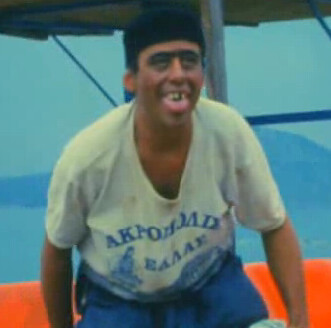 Like last year, I chose the island of Skyros to spend the three-day holiday of Καθαρά Δευτέρα (the Orthodox Lent) which is celebrated together with Αποκριά (Carnival). Having spent successive years in the past going at my origins village outside of Rio (close to Patra) and being pissed off by the commercialization and degradation of the country 's biggest urban carnival, the option of Skyros has emerged well into my annual calendar: close to my native town, Χαλκίδα, dense ferry schedules, and plus, my buddy, who 's serving as a doctor in the island 's tiny hospital.
Like last year, I chose the island of Skyros to spend the three-day holiday of Καθαρά Δευτέρα (the Orthodox Lent) which is celebrated together with Αποκριά (Carnival). Having spent successive years in the past going at my origins village outside of Rio (close to Patra) and being pissed off by the commercialization and degradation of the country 's biggest urban carnival, the option of Skyros has emerged well into my annual calendar: close to my native town, Χαλκίδα, dense ferry schedules, and plus, my buddy, who 's serving as a doctor in the island 's tiny hospital.The island is a personal must; it has many things I adore: a jagged landscape, diversified with forested areas in one side and rough treeless slopes on the other, local folk traditions continuing strong and a very vivid, deeply pagan carnival with loyal fans.
Until the last moment, there was a small debate between me and my companion of going there or not, since the weather forecast for the holiday was quite bad. My initial plans were to go there by motorbike, but F. 's strong objection made me take my car.

The route from Athens to the ferry port of Kymi was changing continuously from rain to sunshine in a very frequent rate, though very scenical and picturesque. When reaching Kymi, the ferry agent informed us that in the hearing of the bad weather, there were some passenger car tickets cancelations which gave us the opportunity to bring the car to the island and thus relieve us of some 70 euros from our pockets.
Shortly after the fully-packed ferry 's got off the Kymi port to the open sea, it started braving a gale-force wind accompanied by thick and wet snowflakes, ramming onto the deck, making everybody in the gallery staring with an open mouth. The ferry 's deep banking was making the passengers unrest but nontheless, remaining very talkative and loudy. In the distance, the snow-powdered lower altitudes around Kymi were revealing a very unusual scenery for us the people of the cities, but not uncommon for the local, both mainlanders and islanders. In about 10 minutes, the storm ended and a hopeful sun appeared; it was the only bad weather to appear for the whole of the holiday.
The Carnival: The sight of Γέρος, the prominent figure of the sheepherd in black, thick wollen cloak, the 40-50 sheep bells strapped around his waist whom shakes and creates a thunderous noise, as if to scare away the goblins. He covers his face in a mask of an aborted tiny goat skin. The whole sight looks awesome and makes the passers step aside to let him pass, being ecstasized of the enormous noise of the bells created by jumping here and there in the narrow cobblestone streets of the island 's capital. Often he is accompanied by a Κορέλα, a man (or recently a role played also by a woman) dressed in the island 's traditional dress with the face covered by a scarf dancing around him and waving another one. It is said that the figure of Γέρος is apparently a shepherd that most possibly lost his sheep in a storm, gathered their bells and coming down to his cottage in sadness and anger and Κορέλα tries to comfort him. The celebrations reach their peak on Sunday, where 20-30 Γέροι and Κορέλες can be seen gathered together, grooving in ecstasy and shaking their bells and us the tourists taking pictures of them. It is very interesting that almost the same tradition appears in the Mamoiada village in Sardegna, where the Mamuthones in almsot very similar outfit are striking their bells: http://www.museodellemaschere.it/museo.htm and http://www.stonepages.com/sardinia/sites/mamuthone.html
The Lent is another surprise: all of the people were down on the streets, having put tables, eating, drinking and treating the passers, knwn or not, from early midday to midnight and even later. Almost every local was dressed in the traditional costume, I even noticed some British and Dutch women wearing it! What I liked at most was the friendliness of the people and a common sense of celebration, no just another boring visit to an uknown place, just waiting for the next week to start.
I also visited the Rupert Brooke 's grave in the southern part of the island, a young British pro-war poet perished by malaria and buried there, while en route to Galipoli, scenery of the notorious 1st World War battle, while serving as a soldier. The grave lies in a small olive grove and can be passed almost unnoticed: no signs, no path, nothing; unless told so by the young guard of the military base, not far away from there.
Up on the hills, close to Brooke 's grave, a small heights meadow with a pond had attracted our attention: some of the famous Skyros dwarf-horses had come down off the mountain to relieve their thirst. Wild as hey are, they couldn 't accept our presence, and after we got too close, they fled. Hopefully, I managed to take some pictures of them, thanks to my 300mm telephoto lens.
